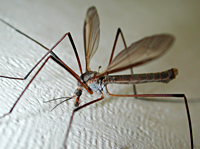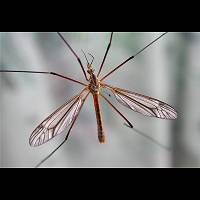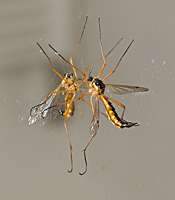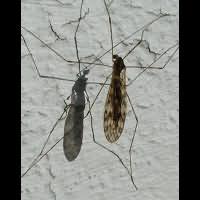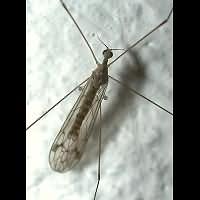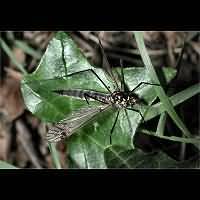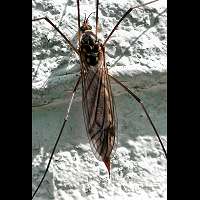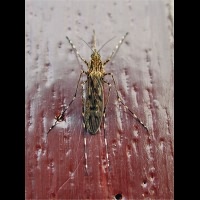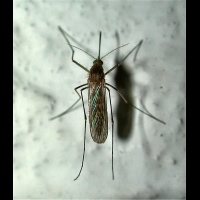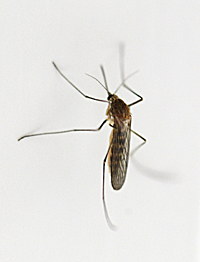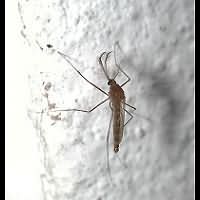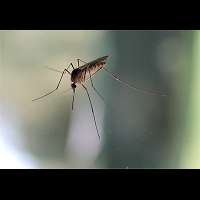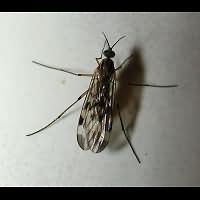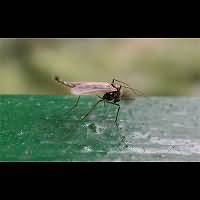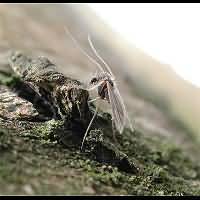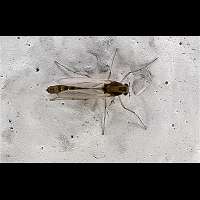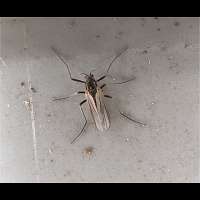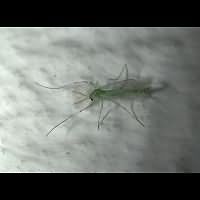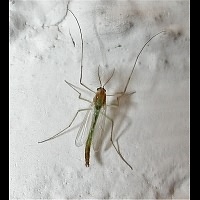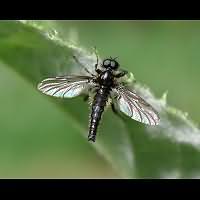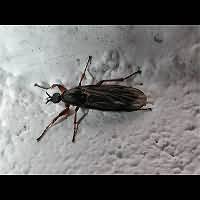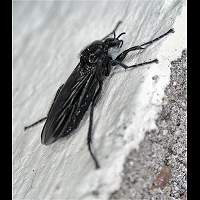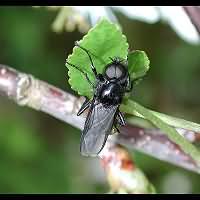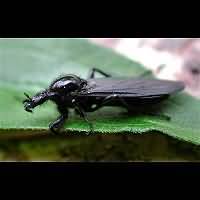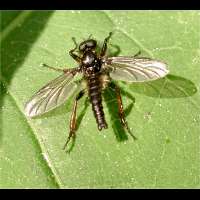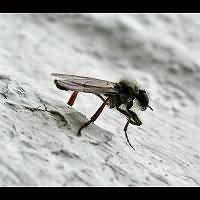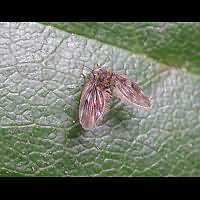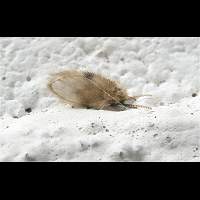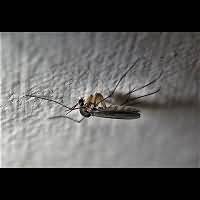[All pictures of garden wildlife on this page are thumbnails. Click on any thumbnail for a large format to be displayed.]
Introduction to Crane Flies and Gnats (Nematocera)
Gnats are the most primitive Diptera. Compared to flies they have longer antennae. They are more slender than flies and usually have much smaller eyes, except for the males of Fever Flies. Gnats are responsible for spreading a number of serious diseases, such as malaria, dengue and yellow fever. The mosquitoes in Western Europe and the USA do not carry any of these diseases, but there are irritating biters among them. Most gnats, such as the green species and the woodgnats, are harmless and will never bite you at all. Some gnats may be seen in large groups, dancing over the pond. Some species even do so in the middle of winter.
Contents: 1 Crane Flies, 2 Gnats, 3 Wood Gnats, 4 Fever Flies, 5 Moth Flies, 6 Fungus Gnats.
![]()
Among the flies and mosquitoes in Europe crane-flies are striking, because they are much bigger than the other Diptera flies. The biggest Crane-fly of them all, a tropical species, may reach 7 centimetres (or 2.8"). Crane-flies do not sting people, as a matter of fact most adults don't even eat at all. The larvae however eat grassroots, thus causing brown patches in the lawn or meadows. Farmers and gardeners are not fond of these larvae, better known as leather-jackets, at all. Luckily some species of birds, especially the Rook and the Black-headed Gull, are fond of them and also Hedgehogs will eat them when given a chance. We do not know the identity of the species below to the left. Depicted below to the right most probably the male of Tipula vernalis, a species seen in springtime mainly.
To the left a typical Crane Fly Tipula padulosa. In the center most probably Tipula vernalis. To the right the spectacular Cone-horn cranefly.
There are more crane flies in Western Europa. Actually there are about 90 species in the Benelux alone.Most of these are much smaller than the Tipula species and their larvae live in decaying wood. Some species have yellow stripes (like many of the hover flies) to immitate wasps. Just like Harvestmen, Crane flies may confuse their enemies by shedding a leg. That is why so many have less than the usual six legs.
Two smaller crane flies. We believe the one on your left to be a Limonia species.
The crane-flies belonging to Nephrotoma show some more colours. They are commonly known as Tiger Crane Flies. The one to the left below shows some of the spots, but is black mainly. We are not sure about its identiry. In early spring 2005 the species below to the right suddenly turned up in our garden in rather great numbers. It took us a long time to get a definite ID on this one. There is rather little information at hand on the numerous Tiger Crane Flies, alas. It turned out to be Nephrotoma appeniculata.
To the left a Tiger Crane Fly we haven't been able to identify yet. To the right the dark, shiny and beautifully marked Nephrotoma appeniculata.
This is a dreadful family of small to medium sized mosquito like creatures. Most of the stinging species in the world belong to this family. The head carries a well protected injection needle. When a victim is found, the case that protects the needle is lifted and the needle is injected. Then the animal excretes a substance to prevent the blood from congealing. Now this is the most dangerous part of the process, for this is the moment infected animals inject diseases into man's bloodstream as well. Next the animal sucks blood for some five minutes and flies off. Only female mosquitoes sting, the males are harmless, most can't bite at all as they do not have functional mouth organs. The female needs the blood to produce her eggs. The blood contains some proteins that she can not make herself. The Common Mosquito is the one that spoils so many nights in fall. The Banded Mosquito (also known as Banded-legged Mosquito) is the biggest species of bloodsucking mosquitoes in Western Eutope.The House Mosquito (in the USA also known as Northern House Mosquito) to the right prefers birds over people, but overwinters in our homes and thus is seen very often.
To the left the Banded Mosquito (Culiseta annulata) and in the middle and to the right the House Mosquito (Culex pipiens).
As males do not bite it is good to be able to tell the difference between the two. In mosquitoes that is much easier than you might expect. Males have huge, plumelike antennae. The Common Mosquito below is one of the most awful species, at least in Western Europe. It often sucks blood out of humans. Even the males are a nuisance. Even though they won't bite, they fly about at night buzzingly, keeping you just as awake as the females do...
This probably is the worst of them all: the Common Mosquito (Aedes punctor). A male to the left and a female to the right.
3 Wood Gnats (Anisopodidae and Chironomidae)
Some Wood Gnats do look like the ordinary Gnats, but luckily Wood Gnats are harmless animals, that will never sting anyone. Still the Window Gnat is often killed by humans for it looks like a biting Gnat very much. The two families of Non-Biting Gnats are also known as Midge Flies. The Window Gnat is one of the better known gnats, for it is attracted to light and can be found near windows, especially in spring time. The adults can be found all year long, though. The larvae live in rotting plants and rotting plant parts. Adults appear in two variations: greyish black or reddish.
This is the very well known Window Gnat (Sylvicola fenestralis).
The larvae of the true wood gnats (Chironomidae) all live in water. The adults often dance in the air in enormous numbers. There are however other mosquito families of which some species swarm. These dances are often part of the mating ritual: the males dance together and the females select the perfect mate. Biting and non biting gnats really do look like oneanother. Still in some cases it is easy to tell them apart, especially resting on a wall or tree: the biting animals all have their last legs up in the air. The non biting species however put their first pair of legs into the air. Like in many other mosquitoes the difference between the male and the female are in the antennae: those of the mail look like big brushes, those of the female are hard to notice. Thank you Tony Irwin for your help identifying these gnats.
Two unidentified Chironomidae species. To the left a male, to the right a female.
Gnats make up a big family of well over 300 species in Britain. Many species are very similar indeed. Thus it is virtually impossible to tell the species apart from pictures alone. This is true for other groups as well, like the parasitic wasps for instance. Below a few recently photographed gnats. We have no idea what species we are talking about. It is interesting to notice the very short antennae of many of the females.
Two more Gnats, which can't be identified from just a few pictures.
Within the Chironomidae family there is a well known tribe of green species called Blood Worms. They are named after their larvae which are red and often sold for feeding fish. These mosquitoes are often seen in groups dancing in the air, sometimes even in the middle if the winter. Only in close-ups can one admire the beauty of these creatures.
Here are two adult Blood worms (Chironomus sp. or Tanytarsus sp.).
4 St. Mark's Flies (Bibionidae)
The females of St. Mark's Flies usually have small eyes, while the males have strikingly huge eyes and that's why they're called flies. In springtime you often find numerous small fly looking mosquitoes of the Bibio generus. Dilophus species also appear in spring, but their small eyes give them away easily. And then there are many other species of small black flies and mosquitoes around in spring, most of which are simply called Black Flies. You'll have to consult an expert to tell all the species apart. Based on findings in books and the internet our guess is that to the left below is a male Hawthorn Fly. Judging from the more colourful legs the one below to the right could be a female Black Gnat.
The the left probably the Hawthorn Fly (Bibio varipes) and to the right perhaps the Black Gnat (Bibio johannis).
The best known species is the real St. Mark's Fly. There are however two species with the same common name: Bibio marci and Bibio hortulanus. We are not sure at all which of these species is depicted below. The one with the big eyes is the male though...
This is probably the St. Mark's Fly (Bibio marci or Bibio hortulanus). In the middle a male, to the left and right a female.
There is another, rather small and very hairy species: Bibio lanigerus. It is a very common species in most of Britain, but you have to look carefully if you want to identify it. It looks like the Hawthorn Fly a lot, but it has reddish legs, at least partially, while the Hawthorn Fly has black legs. In both species we see the same kind of difference between males and females.
Bibio lanigerus. To the left a male and to the right a female.
The Moth Flies are very interesting mosquitoes indeed. They do look like tiny moths a lot, buet they are absolutely not. Their wings have lots of hairs, but no scales like those of moths. Furthermore they have only one pair of wings, where moths have two pairs and finally they lack the long tube-like tongue of the moths. They are called flies, but their antennae give them away: they actually belong to the mosquitoes. Usually species from two major genera are seen. The Pericoma-species, the majority of which have dark and well marked wings and the Psychoda species, which usually have whitish, greyish or silvry wings, which are rather unmarked. In English the Moth Flies are also called Owl midges. They are sometimes seen indoors. Usually a drain is broken, or there is standing and polluted water under or near the house in some other way. The insects are harmless, but often unwanted, especially in great numbers.
A Moth Fly looks like a moth, but is a mosquito. To the left a dark-winged Pericoma species and to the right a silvry winged Psychoda species.
6 Fungus Gnats (Mycetophilidae)
The Fungus Gnats are small to very small gnats. Their thorax is always rounded effecting in the animal always looking downwards. Most species have long legs, but a segment is always going upwards. In most species one of the segments is thickened. The larvae of some species are specialized on fungi, others live in decaying leaves. The specialized ones enter a fungus from the middle or top, for that is the place the eggs are deposited. The ones living in leaf litter often enter the toadstools from the base. Without microscope it is very hard to tell the various species apart.
This is a Fungus Gnat, even though we do not know to which species it belongs.

© Copyright 1998-2024 gardensafari.net (Hania Berdys)

 English / engels
English / engels  Dutch / nederlands
Dutch / nederlands